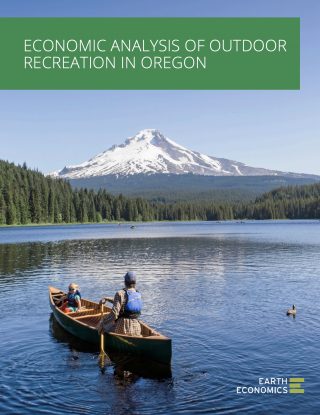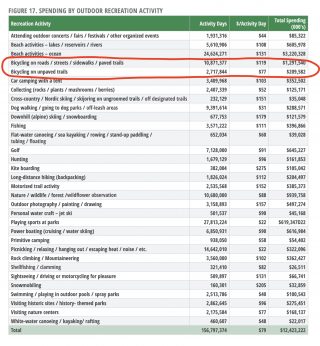
(Photo: Jonathan Maus/BikePortland)

An in-depth analysis of spending in Oregon found that cycling is one of the most economically valuable forms of outdoor recreation in the state.
The Outdoor Recreation Economic Impact Study released last week by Travel Oregon (in partnership with the Oregon Parks and Recreation Department, Oregon Office of Outdoor Recreation, Oregon Fish and Wildlife and Earth Economics) found that in 2019 outdoor recreation supported more than 224,000 jobs statewide and generated $9.3 billion in wages and compensation. The study also found that in 2019, outdoor recreation in Oregon supported $15.6 billion in spending, which includes everything from trip-related spending (money spent on recreational trips), to expenditures on equipment-related spending (outdoor recreation gear, apparel, equipment, and repair).
The study was done to give local leaders more information about the value of outdoor recreation and help them tailor projects, policies, and programs to encourage more of it. The State of Oregon sees outdoor recreation as a valuable asset — for both tourists and locals — that can boost economies in cities large and small. Activities were separated into 32 categories and the study focused on three major data points: total number of days spent doing each activity, spending on trips, and spending on equipment.
When the receipts were tallied, bicycling was at the top no matter how you look at the numbers.
Advertisement

The two bicycling-related categories (split into paved and unpaved) combined for 13.4 million “activity days” — fourth highest among the 32 recreational activity categories. The study counted more people bicycling than golfing (7.1 million), hunting (1.7 million), and rock/mountain climbing (3.5 million) combined.
Bicycling accounted for the third highest amount of spending per day — $196 — behind only kiteboarding and snowmobiling. In total, bicycling accounted for over $1.5 billion in total spending, second among all activities and only behind the “Beach activities – ocean” category.
If you’re curious how this shakes out in a real-world example, the study shared a sample profile of a “local park recreationist” that happened to be a bicycle rider:
A Portland resident gets off work, immediately hops on his recently acquired bike and meets up with his friend for a ride around Forest Park – a Wednesday tradition. More often than not, tradition holds that they have an after-ride beer when they get back to the city. Stopping by the brewery, they spend five bucks on beer and hit the nearby food truck. While these purchases seem small and insignificant, adding up to a little less than $15 by each, the cumulative impacts of thousands of individuals taking part in similar traditions add up to real income for the brewer and the food truck operator. The food truck worker and brewery server earn wages which are then re-spent on living expenses. Further, the hop farmer in the mid-Willamette Valley relies on brewers in Portland selling their beer so they continue to place orders. What all started as a simple evening tradition sets off a chain reaction of economic effects.
This study is a great resource for planners and policymakers. It’s also excellent news for cycling advocates who want the state to pay more attention to their needs.
Learn more about the study and download a copy of the report at TravelOregon.com.
— Jonathan Maus: (503) 706-8804, @jonathan_maus on Twitter and jonathan@bikeportland.org
— Get our headlines delivered to your inbox.
— Support this independent community media outlet with a one-time contribution or monthly subscription.

